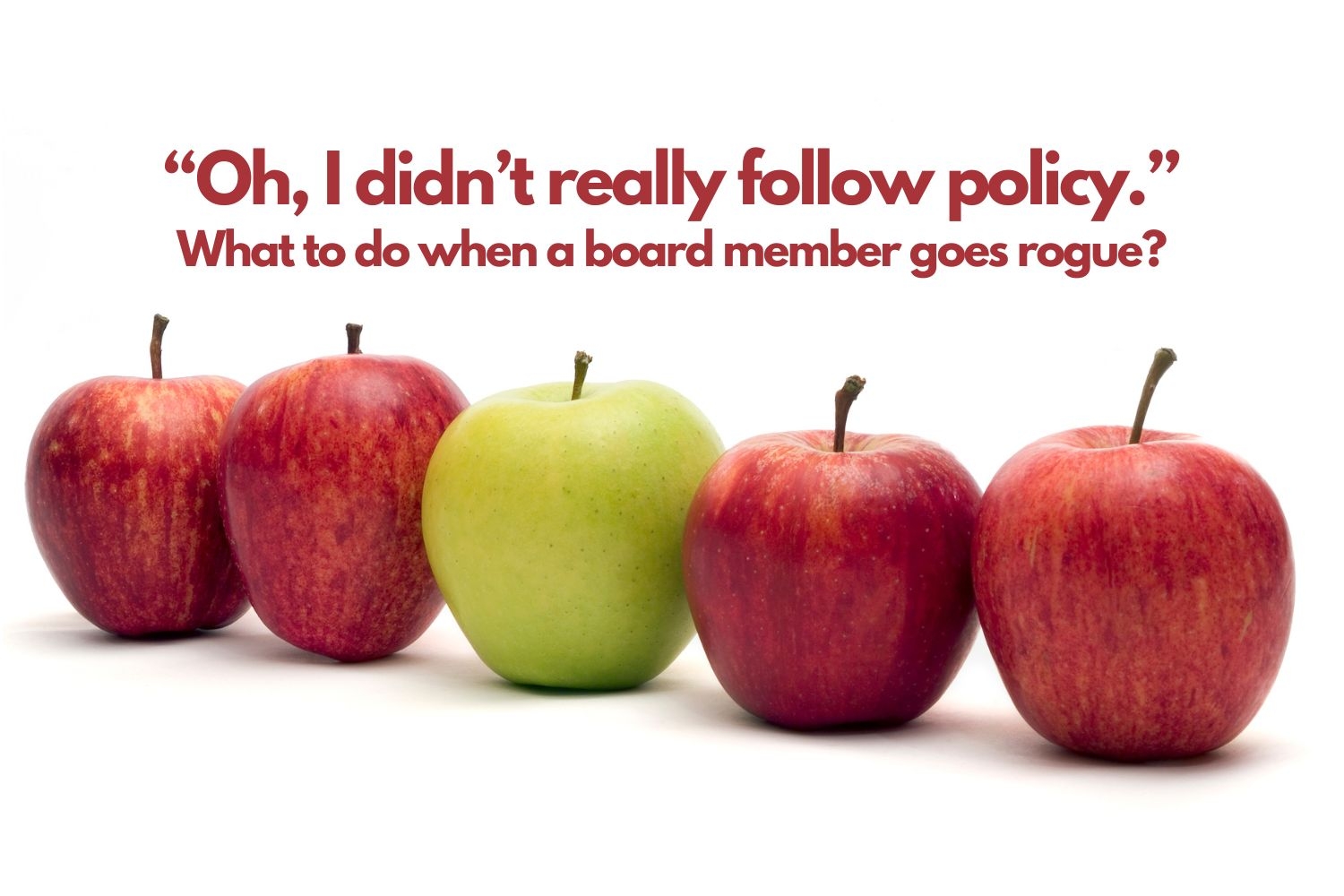What do you do when a board member goes rogue?

Has there been a time when a board member didn’t follow policy and no one, you or other board members, said anything?
Has a board member reported tasks that they’ve handled when they were neither asked, nor given the authority, to handle those tasks?
Has a board member been making decisions away from board meetings and expecting the rest of the board to be grateful for all the hard work? What if those decisions substantially alter the strategic or operational direction of the organization?
How did you get to this point where a board member is running rogue?
It does happen. A board member wants to pursue a different path than that which was developed collectively in the strategic plan. They’ll be a bunch of reasons; from they don’t like the way the executive director is managing the organization, to they’re just trying to help, and even that they don’t really care about policy and want to be free to make decisions on their own.
Left un-addressed and eventually the organization will drift from the strategic plan. Is that so bad? Well, yes. The strategic plan represents the collective needs of the stakeholders. The stakeholders are the reason the organization exists. The board is elected to represent those stakeholders. If the board is following the personal interests of a rogue board member, they will lose touch with the very people they’ve been elected to represent. Then the non-profit risks a major disconnect with its reason for existing and may even be reported to governing agencies, risking registered charity status and the legal approval to operate.
Skip the one-on-one confrontation (for now). Let’s talk about what you can (safely) do to get to the bottom of the problem.
1. Do board members understand their role?
When was the last time your organization held a governance training? No matter the type of board, governance training should (1) clarify the board speaks with one voice principle (this is a biggee), (2) help clarify what kind of board you have, (3) who the board works for, (4) who works for the board, and (5) how the board handles internal discipline. If you’ve held a governance training recently, did it cover these topics as a minimum? If not, it might be time for a refresher.
Bring in a qualified, but external, facilitator to lead the discussion. Someone removed from the organization is more likely to be received as an expert. Be sure to connect with the facilitator a few times before the training to go over the problem areas you need addressed.
2. Is board discipline clear?
Whose job is it to reign in the rogue board member? Look first for a policy outlining board discipline. Often it falls to the Chair, and that might be the problem. Maybe the Chair doesn’t want to be the one in charge of confronting board members who get off track. Some Chairs are comfortable with this role, and some are not – and that’s OK. If the board has a policy, SOMEONE needs to bring situation to the board table for further discussion, by following that policy step by step.
If there is no policy to use as a guide, introducing the idea of creating a policy, is a great place to start. Sometime the discussion that will happen during the creation of a policy, will be enough to resonate with the rogue board member, who will self-correct.
3. Does the board complete an evaluation after each meeting?
Using a self-evaluation at the end of each meeting, is a good start to identifying problems on the board. If an evaluation can be completed anonymously, it gives timid board member a vehicle to address a concern, without risking retribution.
Like a discipline policy, if the board is already using a meeting evaluation, issues with a rouge board member can be brought up that way. If there is no evaluation being used, the discussion of creating one, might help the rogue board member self-correct.
4. When was the last time you held a strategic planning session?
If a non-profit organization is truly responsive to its members, stakeholders, and clients, it will likely have a vision, mission, and strategic plan that were developed based on their need and wants.
An annual strategic planning session, or check-in, can go a long way to help a board member feel they have input into the direction the organization is taking. Holding a planning session with an outside facilitator, will avoid any one person from taking the blame for identifying the rogue board member.
5. Is it time to speak to the board member?
If all the previous suggestions have been tried and nothing worked, now is the time for someone to sit down with the rogue board member for a one-on-one conversation. Who handles that?
This is a step that needs to be carefully nuanced. #warning #proceedwithcaution
While the board chair, or vice-chair, should be handling the conversation, the reality is they are people too, and may be too scared to handle the discussion. Someone on the board needs to step up to have the discussion.
As a last resort, the executive director can speak to the board member. This is truly the last person who should handle the matter, because it can be seen as the ED interfering in board matters.
When planning the discussion, consider approaching the situation with the intent to speak privately and avoid any public humiliation for the board member. Sometimes a little privacy can help everyone save face and clear up honest misunderstandings.
What happens if the 5 steps don’t work?
OK, all the suggestions have been tried and nothing has worked. There are two other [harder] alternatives to consider.
Alternate #1: Live with it.
The board will need to decide if it wants to wait out the problem. Board members come and go. Maybe this one will leave, and someone new can be elected. There is a risk, however, that other board members may dislike the inaction and decide to leave.
A board that chooses to live with it needs to be ready to explain to the membership, sponsors, and funders any shifts away from the strategic plan that continue to occur while the rogue board member continues doing her own thing.
Alternate #2: Remove the rogue board member
Never an easy decision. A board would be wise to have first discussed the matter at a board meeting at least once, with the rouge board member present. If proceeding with removal, a board should seek legal advice, and maybe even hire a trained facilitator to guide the process.
This is one of the hardest experiences a board will encounter, but like removing an employee who isn’t doing their job, the organization could well breathe a sigh of relief once everything is done and handled. Remember to keep it professional, legal, and private.
When removing a rogue board member, remember to keep it professional, legal, and private.
A board is best when it works as a team.
In most instances the 5 steps will help a rogue board member come to a better understanding of their role and will create a return to working as a team. When a board really understands how to work together, the team begins to relax. The pressure is lifted from any one person to do more than the other. The fear to speak up during discussions, begins to fade, because everyone is asked for input.
A summary of the 5 steps when a board member goes rogue.
- Board members need to understand their role. A job description or policy should explain it clearly.
- Check for or create a policy for board discipline.
- Use or begin to use an evaluation after every board meeting. An anonymous evaluation is best.
- Ensure strategic planning happens annually. Hire an outside facilitator to guide discussions. Ask the facilitator to focus on the board’s representation of the stakeholders, not individual interests.
- Sit down and talk to the rogue board member. Have the conversation privately.
When a board operates as a team, making decisions together, it is strong.
Thanks for taking the time to read my ideas. My mission is to take the mystery out of running a small non-profit. If you know someone who needs to read this, why not grab the link, and share it with them. Let’s work together to help non-profit boards succeed.
-Christie
…
Hi, I'm Christie Saas, former board member, current Executive Director, and non-profit volunteer. I remember well, those early years when I lacked the training, the confidence, and the work-life balance to focus on becoming the best non-profit leader I could be.
Fast-forward past many bumps in the road, lessons learned, and you’ll find me still in the trenches, but a little wiser, a little calmer, and a whole lot happier. I love my work and I want to help you love yours too.
I created ChristieSaas.com to give you tools, tips, and templates to remove the mystery of learning to run a small non-profit. If you’re a brand-new non-profit leader, or a little more seasoned, someone who’s looking to make a meaningful contribution and still have time for a full life away from the job, you’re in the right place.
© Christie Saas 2022 All Rights Reserved
…
Want to learn more?
Start with one of my free resources.


